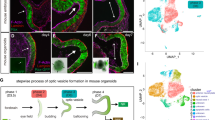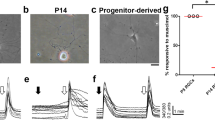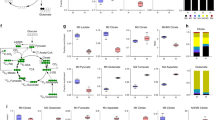Abstract
Unlike healthy adult tissues, cancers produce energy mainly by aerobic glycolysis instead of oxidative phosphorylation1. This adaptation, called the Warburg effect, may be a feature of all dividing cells, both normal and cancerous2, or it may be specific to cancers3. It is not known whether, in a normally growing tissue during development, proliferating and postmitotic cells produce energy in fundamentally different ways. Here we show in the embryonic Xenopus retina in vivo, that dividing progenitor cells depend less on oxidative phosphorylation for ATP production than non-dividing differentiated cells, and instead use glycogen to fuel aerobic glycolysis. The transition from glycolysis to oxidative phosphorylation is connected to the cell differentiation process. Glycolysis is indispensable for progenitor proliferation and biosynthesis, even when it is not used for ATP production. These results suggest that the Warburg effect can be a feature of normal proliferation in vivo, and that the regulation of glycolysis and oxidative phosphorylation is critical for normal development.
This is a preview of subscription content, access via your institution
Access options
Subscribe to this journal
Receive 12 print issues and online access
$209.00 per year
only $17.42 per issue
Buy this article
- Purchase on Springer Link
- Instant access to full article PDF
Prices may be subject to local taxes which are calculated during checkout





Similar content being viewed by others
References
Warburg, O. On the origin of cancer cells. Science 123, 309–314 (1956).
Vander Heiden, M. G., Cantley, L. C. & Thompson, C. B. Understanding the Warburg effect: the metabolic requirements of cell proliferation. Science 324, 1029–1033 (2009).
Gatenby, R. A. & Gillies, R. J. Why do cancers have high aerobic glycolysis? Nat. Rev. Cancer 4, 891–899 (2004).
Jorgensen, P., Steen, J. A. J., Steen, H. & Kirschner, M. W. The mechanism and pattern of yolk consumption provide insight into embryonic nutrition in Xenopus. Development 136, 1539–1548 (2009).
Holt, C. E., Bertsch, T. W., Ellis, H. M. & Harris, W. A. Cellular determination in the Xenopus retina is independent of lineage and birth date. Neuron 1, 15–26 (1988).
Norden, C., Young, S., Link, B. A. & Harris, W. A. Actomyosin is the main driver of interkinetic nuclear migration in the retina. Cell 138, 1195–1208 (2009).
Agathocleous, M. & Harris, W. A. From progenitors to differentiated cells in the vertebrate retina. Annu. Rev. Cell Dev. Biol. 25, 45–69 (2009).
Burke, R. E., Levine, D. N. & Zajac, F. E. 3rd Mammalian motor units: physiological-histochemical correlation in three types in cat gastrocnemius. Science 174, 709–712 (1971).
Perry, M. M. Identification of glycogen in thin sections of amphibian embryos. J. Cell Sci. 2, 257–264 (1967).
Rodriguez, I. R. & Fliesler, S. J. Glycogenesis in the amphibian retina: in vitro conversion of [2-3H] mannose to [3H] glucose and subsequent incorporation into glycogen. Exp. Eye Res. 51, 71–77 (1990).
Klabunde, T. et al. Acyl ureas as human liver glycogen phosphorylase inhibitors for the treatment of type 2 diabetes. J. Med. Chem. 48, 6178–6193 (2005).
Takahashi, S. et al. Estimation of glycogen levels in human colorectal cancer tissue: relationship with cell cycle and tumour outgrowth. J. Gastroenterol. 34, 474–480 (1999).
Schnier, J. B., Nishi, K., Monks, A., Gorin, F. A. & Bradbury, E. M. Inhibition of glycogen phosphorylase (GP) by CP-91,149 induces growth inhibition correlating with brain GP expression. Biochem. Biophys. Res. Commun. 309, 126–134 (2003).
Pellerin, L. & Magistretti, P. J. Sweet sixteen for ANLS. J. Cereb. Blood Flow Metab.http://dx.doi.org/10.1038/jcbfm.2011.149 (2011).
Nakada, D., Levi, B. P. & Morrison, S. J. Integrating physiological regulation with stem cell and tissue homeostasis. Neuron 70, 703–718 (2011).
Hall, C. N. & Attwell, D. Assessing the physiological concentration and targets of nitric oxide in brain tissue. J. Physiol. 586, 3597–3615 (2008).
Hutcheson, D. A. & Vetter, M. L. The bHLH factors Xath5 and XNeuroD can upregulate the expression of XBrn3d, a POU-homeodomain transcription factor. Dev. Biol. 232, 327–338 (2001).
Locker, M. et al. Hedgehog signalling and the retina: insights into the mechanisms controlling the proliferative properties of neural precursors. Genes Dev. 20, 3036–3048 (2006).
Wang, T., Marquardt, C. & Foker, J. Aerobic glycolysis during lymphocyte proliferation. Nature 261, 702–705 (1976).
Brand, K. & Hermfisse, U. Aerobic glycolysis by proliferating cells: a protective strategy against reactive oxygen species. FASEB J. 11, 388–395 (1997).
Birket, M. J. et al. A reduction in ATP demand and mitochondrial activity with neural differentiation of human embryonic stem cells. J. Cell Sci. 124, 348–358 (2011).
Chung, S. et al. Mitochondrial oxidative metabolism is required for the cardiac differentiation of stem cells. Nat. Clin. Pract. Cardiovasc. Med. 4, S60–S67 (2007).
Facucho-Oliveira, J. M. & St John, J. C. The relationship between pluripotency and mitochondrial DNA proliferation during early embryo development and embryonic stem cell differentiation. Stem Cell Rev. Rep. 5, 140–158 (2009).
Cairns, R. A., Harris, I. S. & Mak, T. W. Regulation of cancer cell metabolism. Nat. Rev. Cancer 11, 85–95 (2011).
Gottlieb, T. A. & Wallace, R. A. Intracellular glycosylation of vitellogenin in the liver of estrogen-stimulated Xenopus laevis. J. Biol. Chem. 257, 95–103 (1982).
Yang, C. et al. Glioblastoma cells require glutamate dehydrogenase to survive impairments of glucose metabolism or Akt signalling. Cancer Res. 69, 7986–7993 (2009).
Tu, B. P., Kudlicki, A., Rowicka, M. & McKnight, S. L. Logic of the yeast metabolic cycle: temporal compartmentalization of cellular processes. Science 310, 1152–1158 (2005).
Almeida, A., Bolanos, J. P. & Moncada, S. E3 ubiquitin ligase APC/C-Cdh1 accounts for the Warburg effect by linking glycolysis to cell proliferation. Proc. Natl Acad. Sci. USA 107, 738–741 (2010).
Ozbudak, E. M., Tassy, O. & Pourquie, O. Spatiotemporal compartmentalization of key physiological processes during muscle precursor differentiation. Proc. Natl Acad. Sci. USA 107, 4224–4229 (2010).
Owusu-Ansah, E. & Banerjee, U. Reactive oxygen species prime Drosophila haematopoietic progenitors for differentiation. Nature 461, 537–541 (2009).
Lopaschuk, G. D. & Jaswal, J. S. Energy metabolic phenotype of the cardiomyocyte during development, differentiation, and postnatal maturation. J. Cardiovasc. Pharmacol. 56, 130–140 (2010).
Moran, J. H. & Schnellmann, R. G. A rapid beta-NADH-linked fluorescence assay for lactate dehydrogenase in cellular death. J. Pharmacol. Toxicol. Methods 36, 41–44 (1996).
Carpenter, A. E. et al. CellProfiler: image analysis software for identifying and quantifying cell phenotypes. Genome Biol. 7, R100 (2006).
Acknowledgements
We are grateful to F. Gallagher and H. Sladen for help with the LDH assays, N. Miller for cell sorting and D. Attwell for advice on the oxygen concentration measurements. We thank J. Bixby, C. Holt, S. Morrison, S. He and R. Johnson for comments on the manuscript. We thank the Wellcome Trust (W.A.H.) and Gonville and Caius College and the Royal Commission for the Exhibition of 1851 (M.A.) for financial support.
Author information
Authors and Affiliations
Contributions
M.A. conceived the study, carried out most of the experiments and co-wrote the paper. N.K.L. did the LDH and lactate assays and helped with several other aspects of the experimental work. O.R. did the Eb3–GFP imaging in zebrafish. J.J.H. did the in vivo oxygen recordings. J.L. did the SDH histochemistry. The oxygen consumption assays were done with A.J.M. W.A.H. guided the research and co-wrote the paper.
Corresponding authors
Ethics declarations
Competing interests
The authors declare no competing financial interests.
Supplementary information
Supplementary Information
Supplementary Information (PDF 933 kb)
Supplementary Movie 1
Supplementary Information (MOV 2182 kb)
Rights and permissions
About this article
Cite this article
Agathocleous, M., Love, N., Randlett, O. et al. Metabolic differentiation in the embryonic retina. Nat Cell Biol 14, 859–864 (2012). https://doi.org/10.1038/ncb2531
Received:
Accepted:
Published:
Issue Date:
DOI: https://doi.org/10.1038/ncb2531
This article is cited by
-
Genetic lineage tracing identifies adaptive mechanisms of pancreatic islet β cells in various mouse models of diabetes with distinct age of initiation
Science China Life Sciences (2024)
-
Lactate-dependent transcriptional regulation controls mammalian eye morphogenesis
Nature Communications (2023)
-
Hnrnpk maintains chondrocytes survival and function during growth plate development via regulating Hif1α-glycolysis axis
Cell Death & Disease (2022)
-
Mitochondrial function in spinal cord injury and regeneration
Cellular and Molecular Life Sciences (2022)
-
Impaired oxygen-sensitive regulation of mitochondrial biogenesis within the von Hippel–Lindau syndrome
Nature Metabolism (2022)



